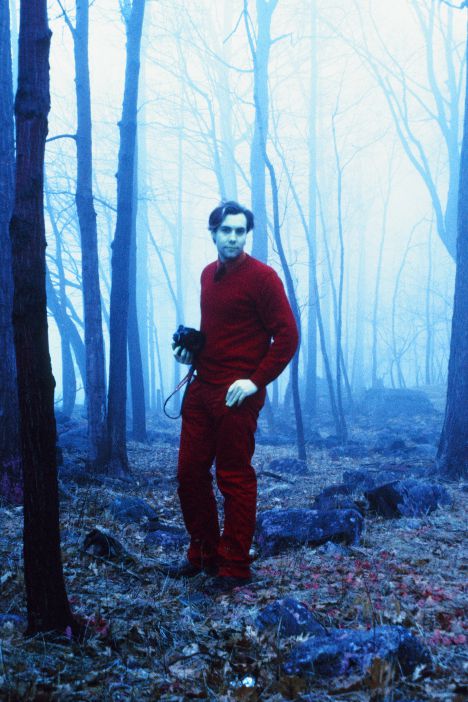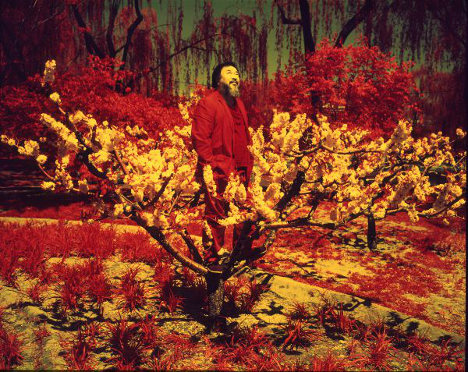Hacker photographer turns lens on dissidents

Privacy activist Jacob Appelbaum’s new Berlin art exhibition aims to show Julian Assange and other famous dissidents in the internet privacy debate in a new light.
Appelbaum’s ‘SAMIZDATA: Evidence of Conspiracy’ at NOME Gallery includes a collection of infrared portraits in which he has captured some of the most high-profile figures in the debate over privacy and internet surveillance.
Gallery & Audio: Portraits of dissidents
Emerging Network
The title of the show refers to the Russian word samizdat, an underground publishing system that distributed dissident writing in the former Soviet Bloc.
One of the goals of the Samizdata exhibit is to illustrate what Appelbaum calls, “a kind of emergent network” that has sprung up, an informal counter-surveillance group if you will.
“I mean it’s clear when all these people are viewed together that they are part of something…So, in a sense being able to show them together as individuals also shows this sort of implicit network that exists,” he told The Local.
The photographs include portraits of his colleagues and friends, like Chinese dissident artist Ai Weiwei, Citizenfour documentary filmmaker Laura Poitras, and WikiLeaks founder Julian Assange shot with infrared film of a type used for aerial surveillance.
Anonymity online

Jacob Appelbaum. Photo: Kate Young
The 32-year-old Appelbaum could have also added a picture of himself to the exhibit.
He’s built an international reputation as a privacy advocate and security expert, a winner of the Henri Nannen prize for journalism for helping reveal NSA surveillance in Germany, and a Julian Assange and Edward Snowden ally.
Appelbaum describes himself as “living in exile in Germany” because he says he’s faced repeated harassment by the U.S. government thanks to his privacy activism.
For Appelbaum, the idea of anonymity online isn’t something to fear.
“Anonymity online is to be at liberty,” he says, seeing he see the internet as a place where one should be able to freely associate and form one's own thoughts.
“There will always be bad actors but sometimes those bad actors wear good cop badges.”
Humanizing his subjects
He also says the exhibit is meant to humanize his polarizing subjects and to illustrate how he sees and wants you to see them.
In the portrait of Julian Assange, taken in 2012, the WikiLeak’s founder looks rather poised and stately.
“I consciously wanted to display a proud person where we were still on the edge of understanding how far this was going to go,” says Appelbaum.
With the more whimsical photo of Ai Weiwei standing in a tree and looking up at the sky, Appelbaum describes it as a rare image of the artist.
“Because he’s in the tree, he puts his phone in his pocket...[N]ormally what he's doing is he's using his phone to film people filming him or photographing him. He’s always recording,” he says.
“You know, there's a weird dynamic that exists with people that work on exposing surveillance…[T]here's a fascination with it.”
‘Samizdata’ runs to Saturday October 31 at the NOME Gallery in Berlin. Along with the portraits, Appelbaum's exhibit also includes works stuffed with shredded Snowdon documents, like ‘Panda to Panda’, a collaboration Appelbaum created with artist Ai Weiwei.
by Debbie Pacheco
Comments
See Also
Appelbaum’s ‘SAMIZDATA: Evidence of Conspiracy’ at NOME Gallery includes a collection of infrared portraits in which he has captured some of the most high-profile figures in the debate over privacy and internet surveillance.
Gallery & Audio: Portraits of dissidents
Emerging Network
The title of the show refers to the Russian word samizdat, an underground publishing system that distributed dissident writing in the former Soviet Bloc.
One of the goals of the Samizdata exhibit is to illustrate what Appelbaum calls, “a kind of emergent network” that has sprung up, an informal counter-surveillance group if you will.
“I mean it’s clear when all these people are viewed together that they are part of something…So, in a sense being able to show them together as individuals also shows this sort of implicit network that exists,” he told The Local.
The photographs include portraits of his colleagues and friends, like Chinese dissident artist Ai Weiwei, Citizenfour documentary filmmaker Laura Poitras, and WikiLeaks founder Julian Assange shot with infrared film of a type used for aerial surveillance.
Anonymity online

Jacob Appelbaum. Photo: Kate Young
The 32-year-old Appelbaum could have also added a picture of himself to the exhibit.
He’s built an international reputation as a privacy advocate and security expert, a winner of the Henri Nannen prize for journalism for helping reveal NSA surveillance in Germany, and a Julian Assange and Edward Snowden ally.
Appelbaum describes himself as “living in exile in Germany” because he says he’s faced repeated harassment by the U.S. government thanks to his privacy activism.
For Appelbaum, the idea of anonymity online isn’t something to fear.
“Anonymity online is to be at liberty,” he says, seeing he see the internet as a place where one should be able to freely associate and form one's own thoughts.
“There will always be bad actors but sometimes those bad actors wear good cop badges.”
Humanizing his subjects
He also says the exhibit is meant to humanize his polarizing subjects and to illustrate how he sees and wants you to see them.
In the portrait of Julian Assange, taken in 2012, the WikiLeak’s founder looks rather poised and stately.
“I consciously wanted to display a proud person where we were still on the edge of understanding how far this was going to go,” says Appelbaum.
With the more whimsical photo of Ai Weiwei standing in a tree and looking up at the sky, Appelbaum describes it as a rare image of the artist.
“Because he’s in the tree, he puts his phone in his pocket...[N]ormally what he's doing is he's using his phone to film people filming him or photographing him. He’s always recording,” he says.
“You know, there's a weird dynamic that exists with people that work on exposing surveillance…[T]here's a fascination with it.”
‘Samizdata’ runs to Saturday October 31 at the NOME Gallery in Berlin. Along with the portraits, Appelbaum's exhibit also includes works stuffed with shredded Snowdon documents, like ‘Panda to Panda’, a collaboration Appelbaum created with artist Ai Weiwei.
by Debbie Pacheco

Join the conversation in our comments section below. Share your own views and experience and if you have a question or suggestion for our journalists then email us at [email protected].
Please keep comments civil, constructive and on topic – and make sure to read our terms of use before getting involved.
Please log in here to leave a comment.